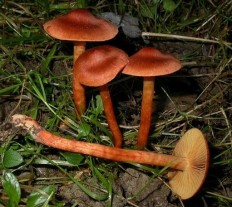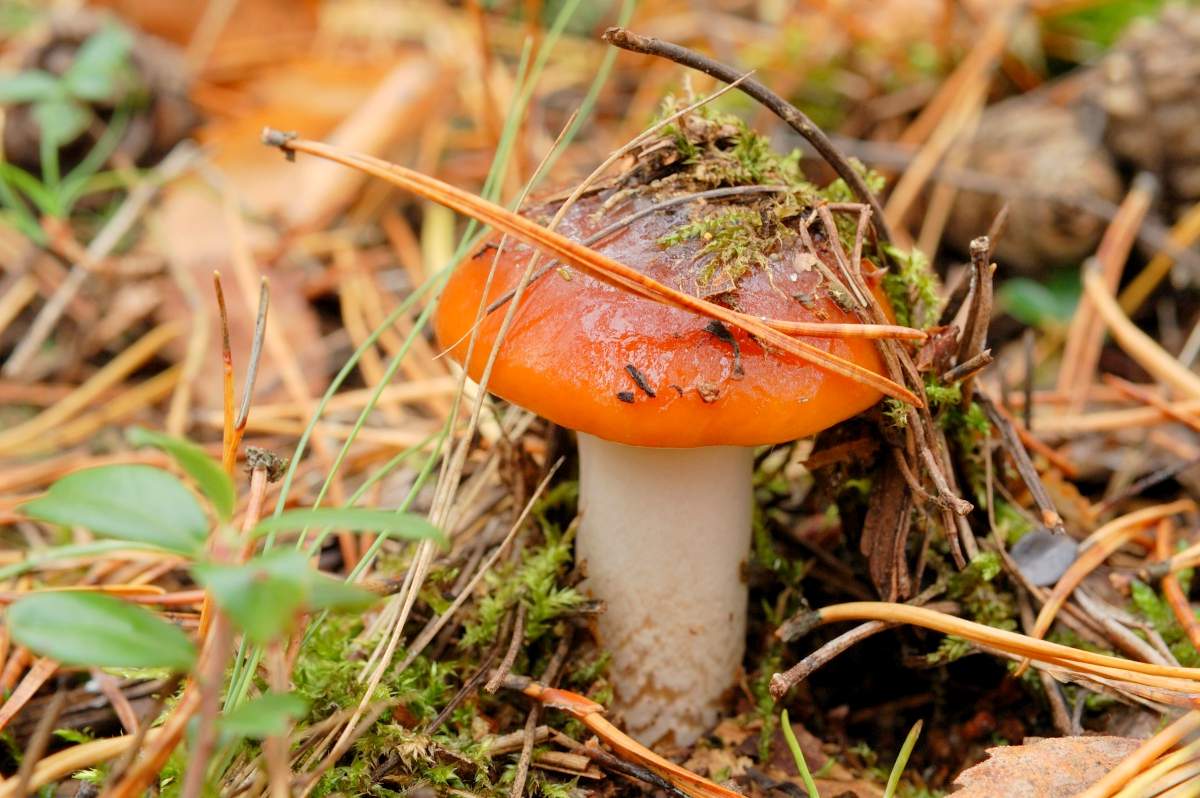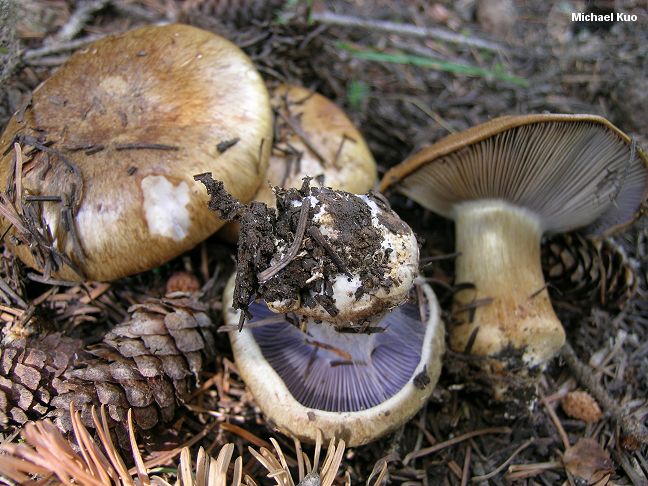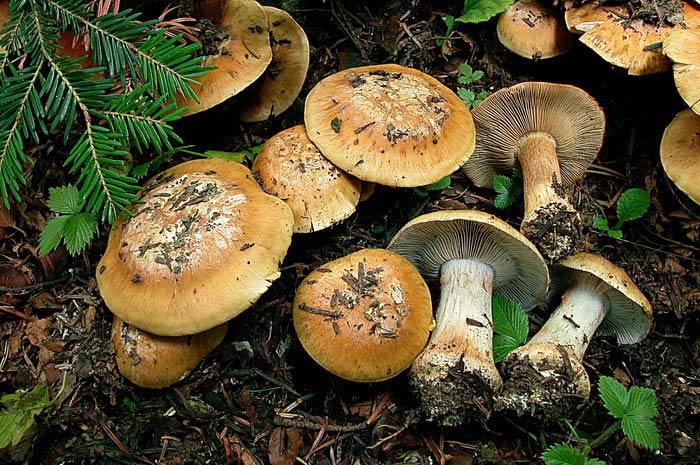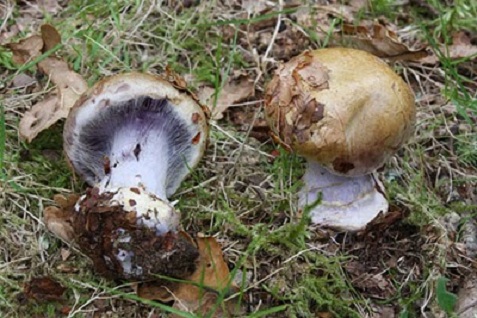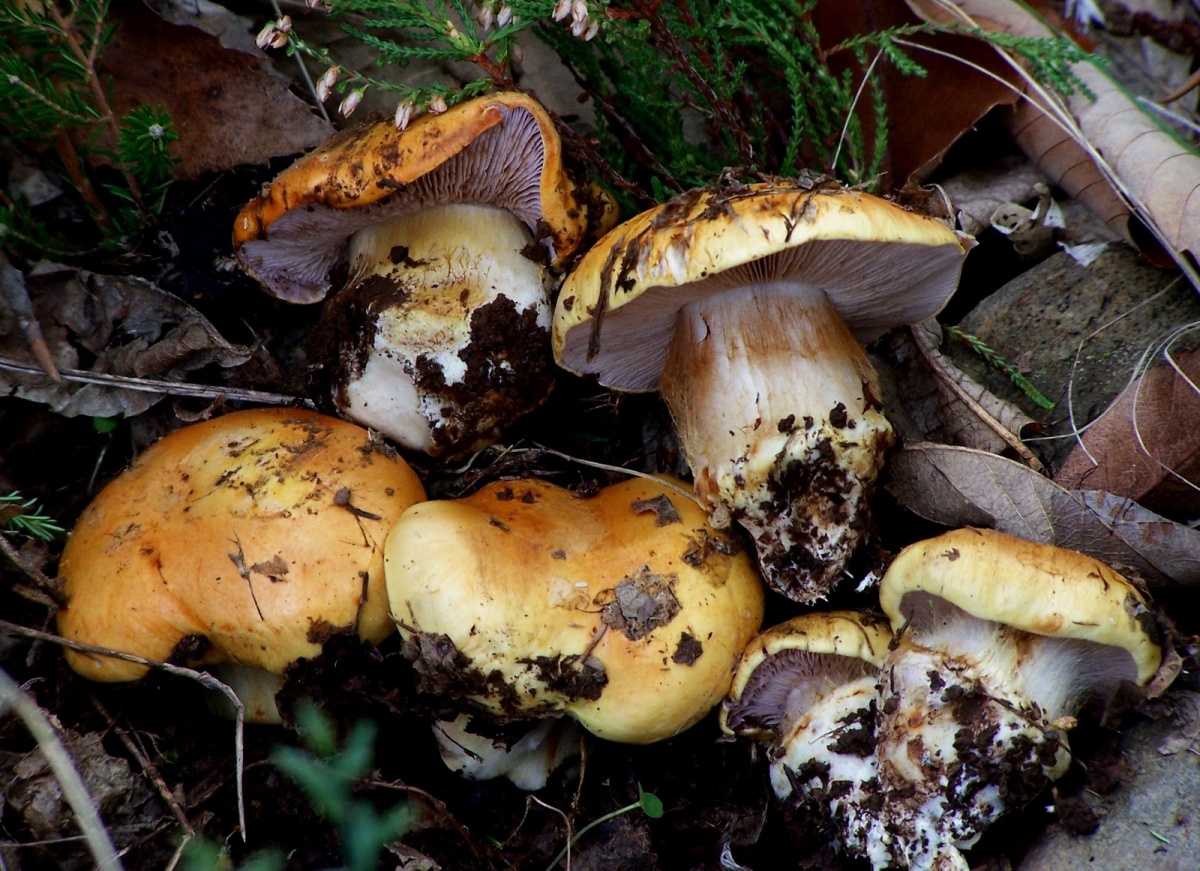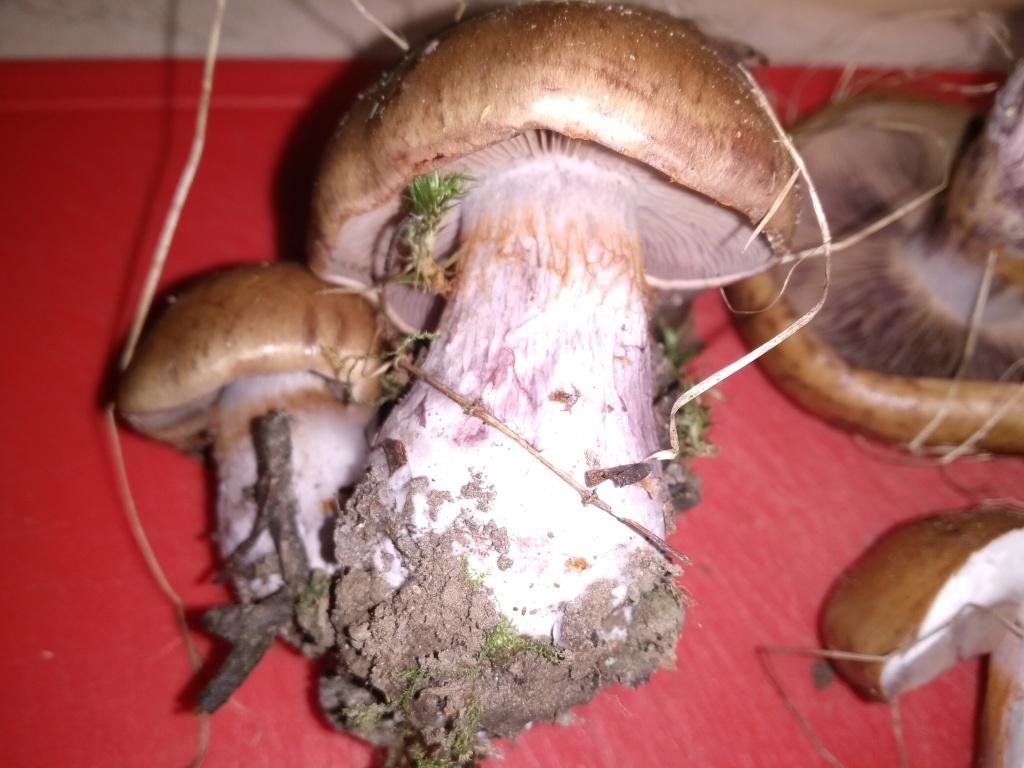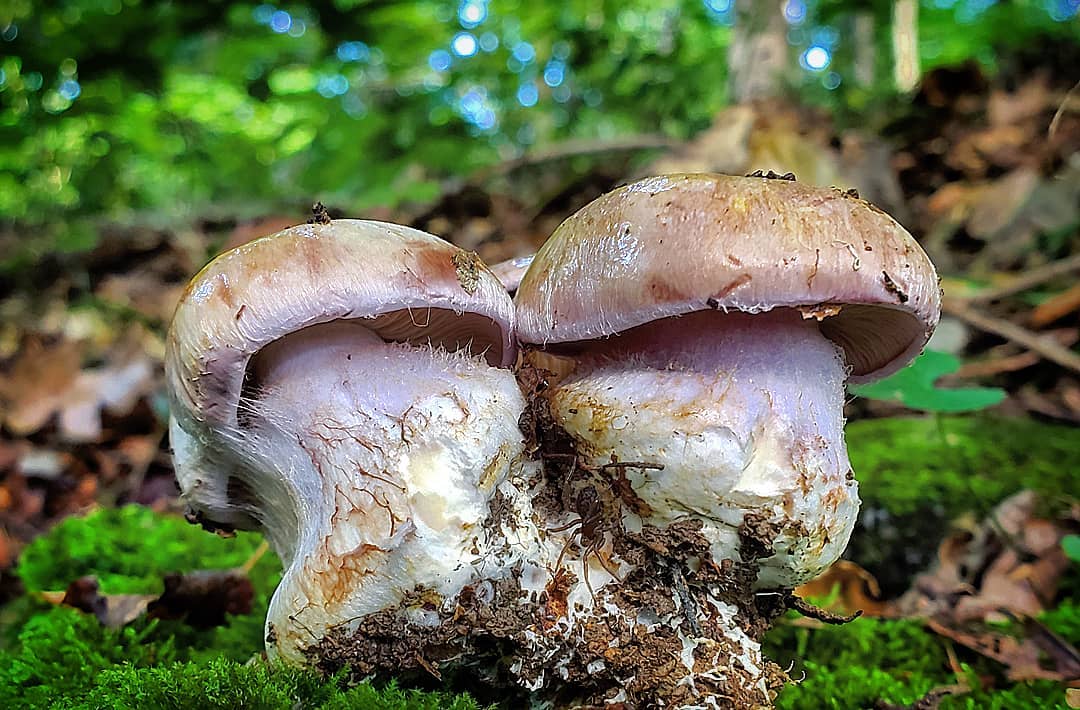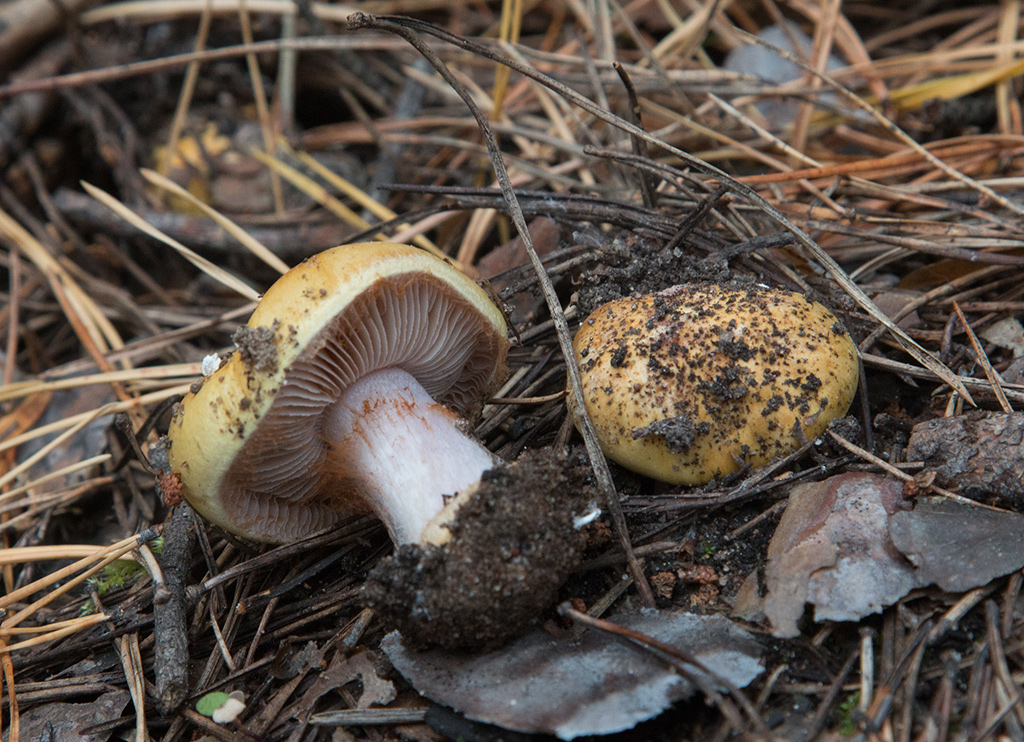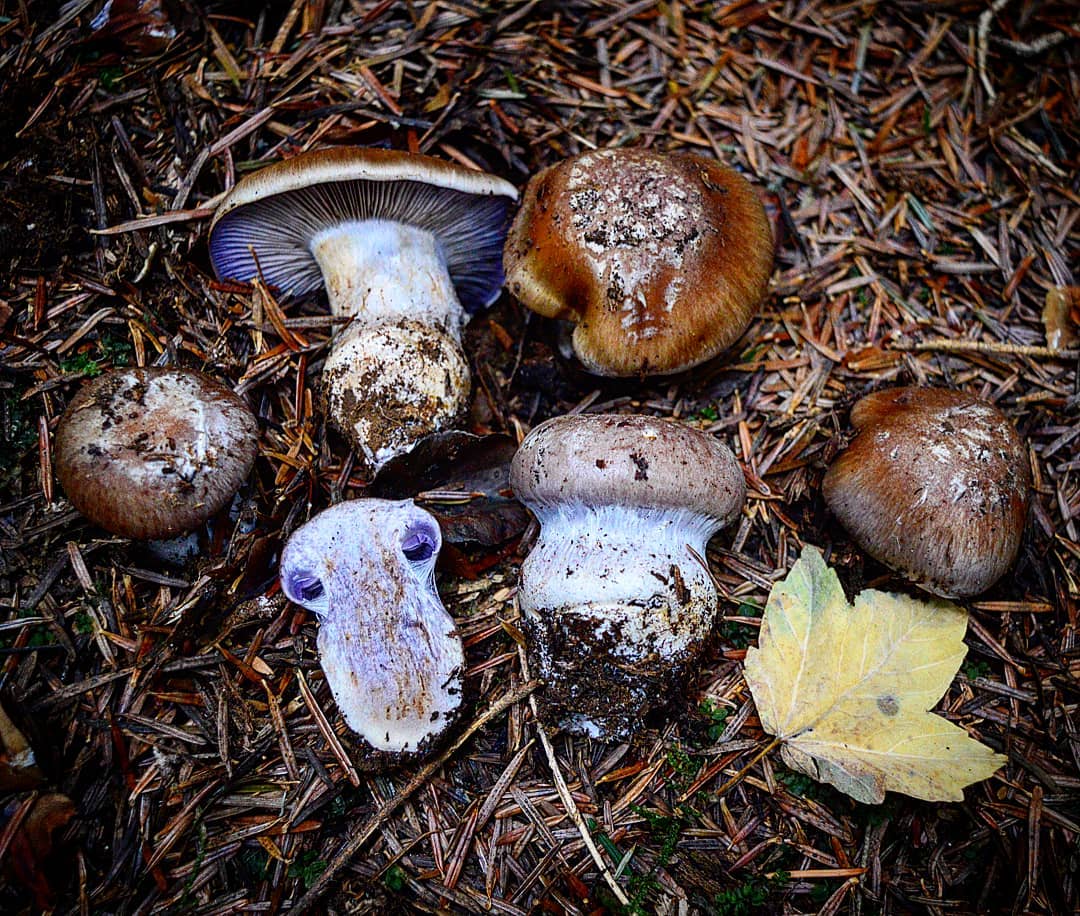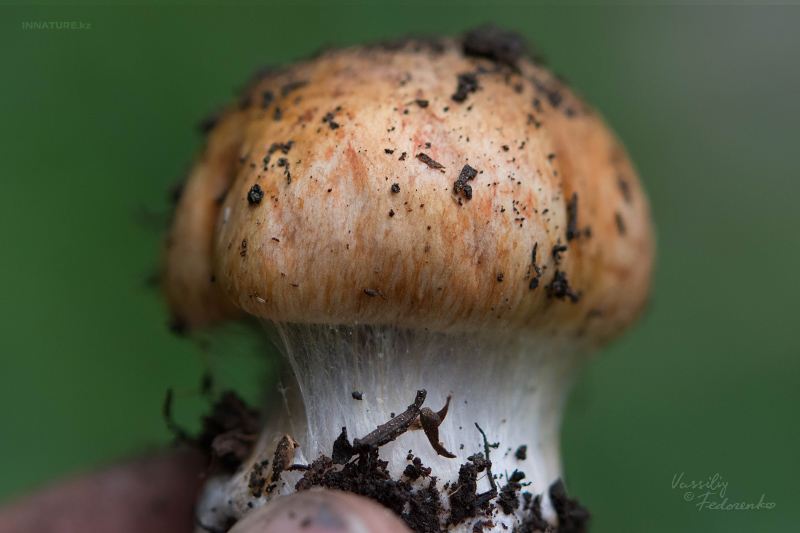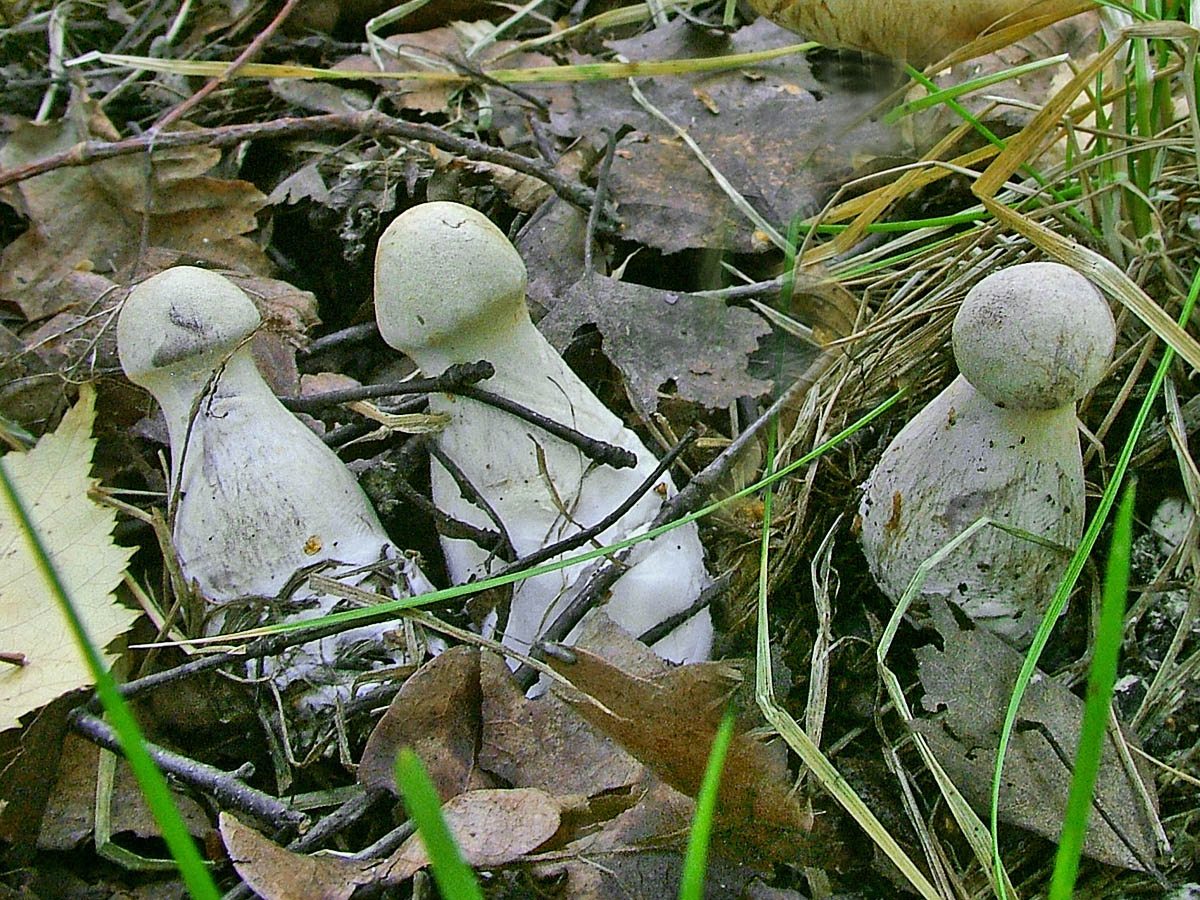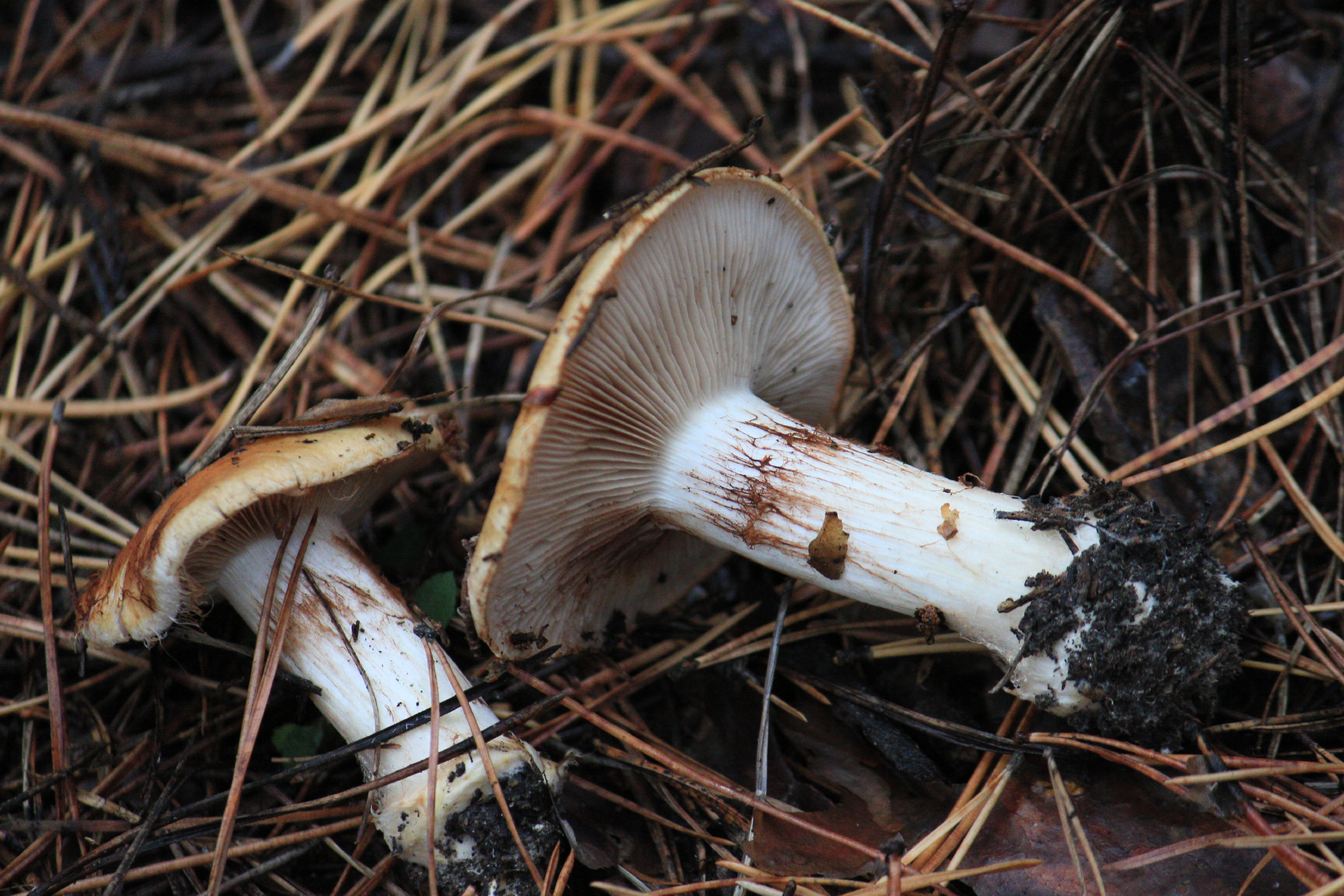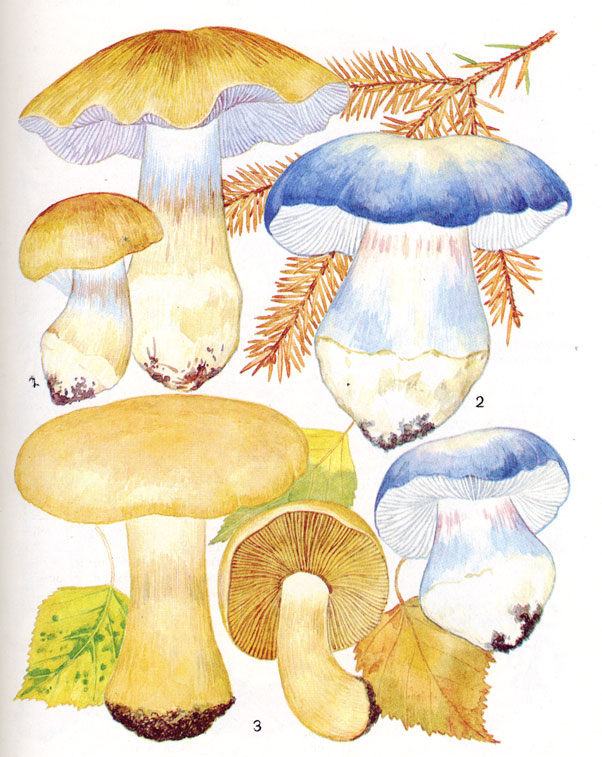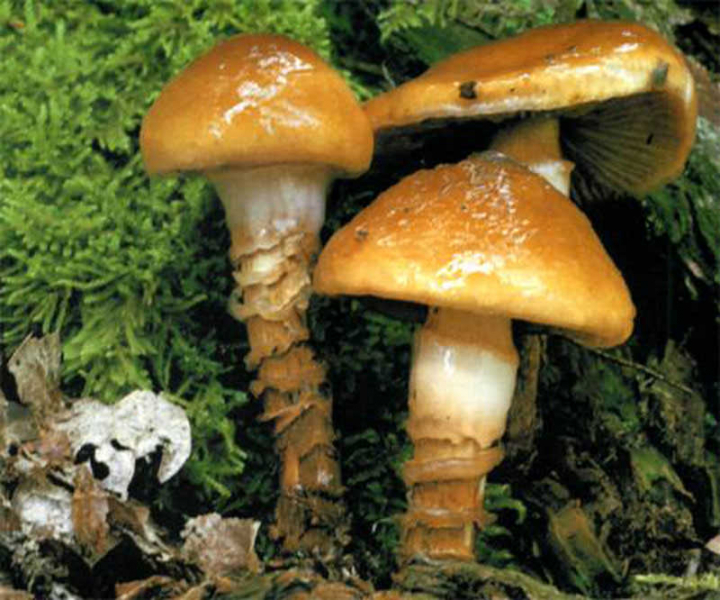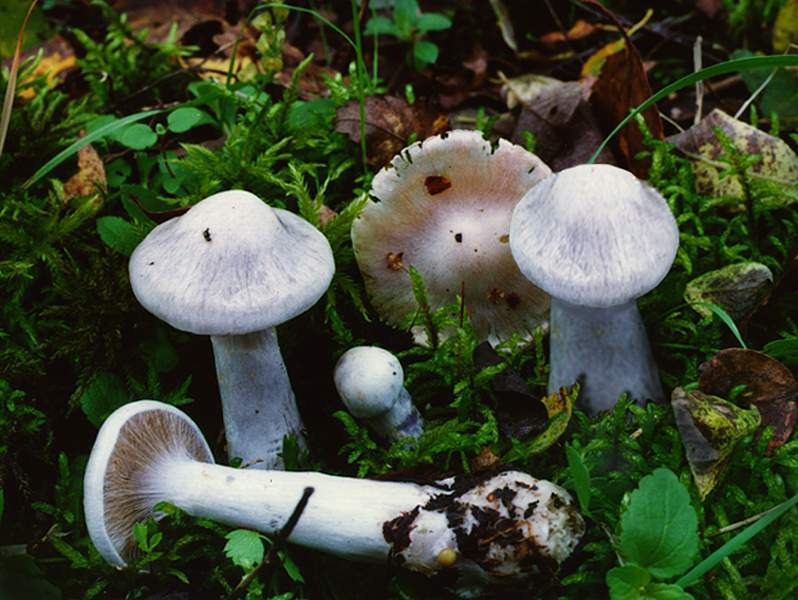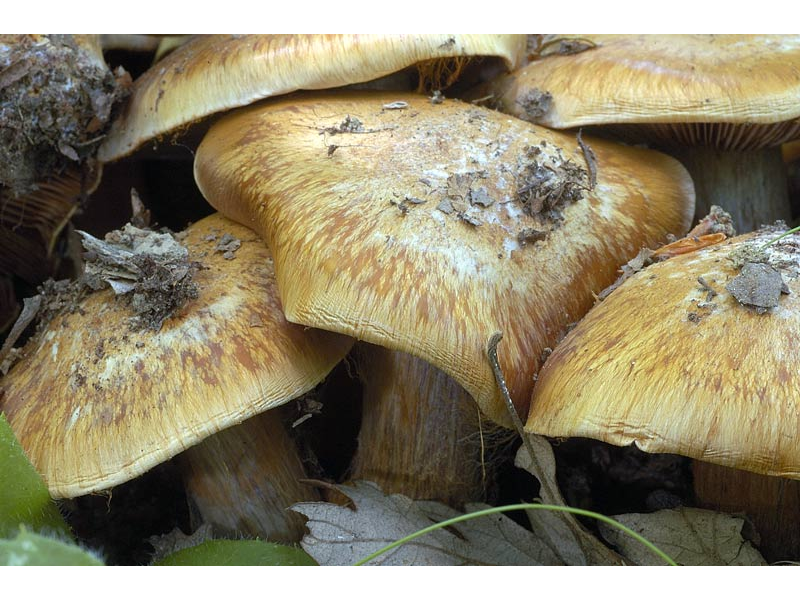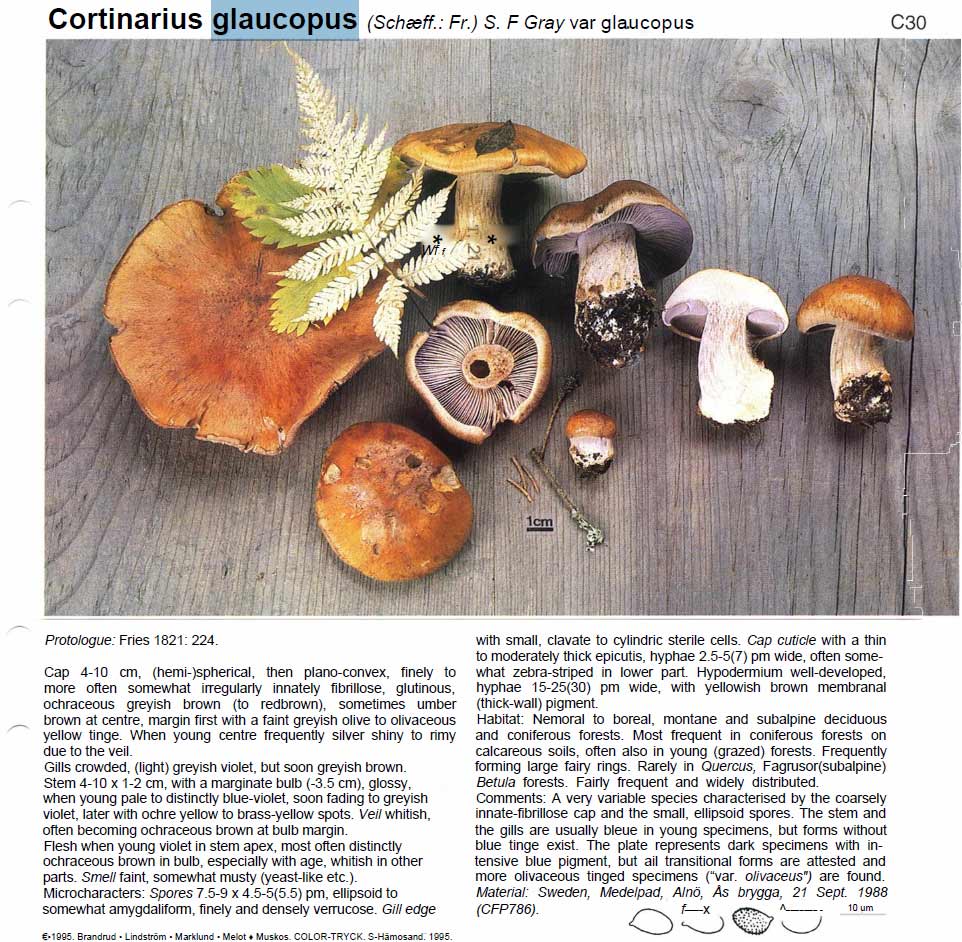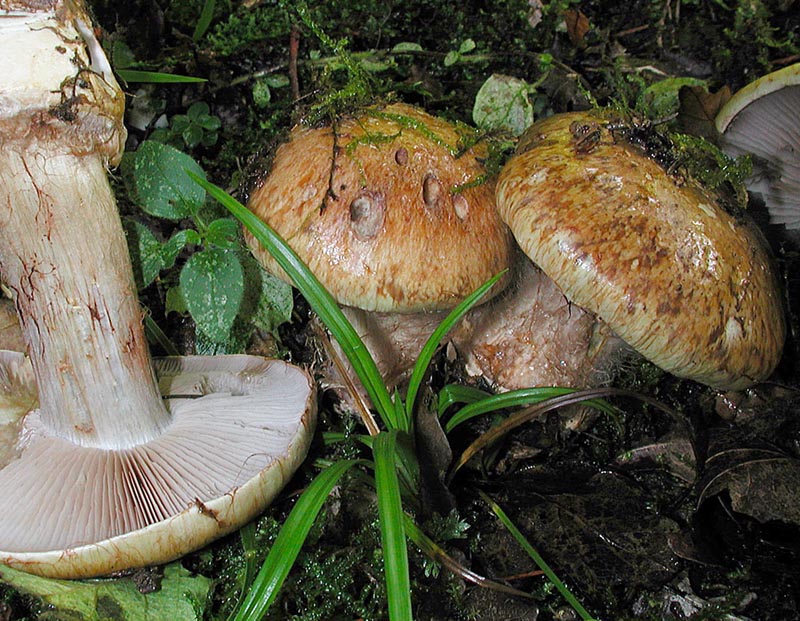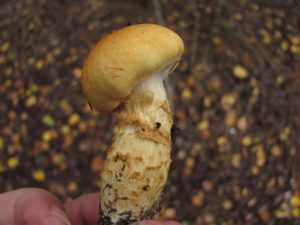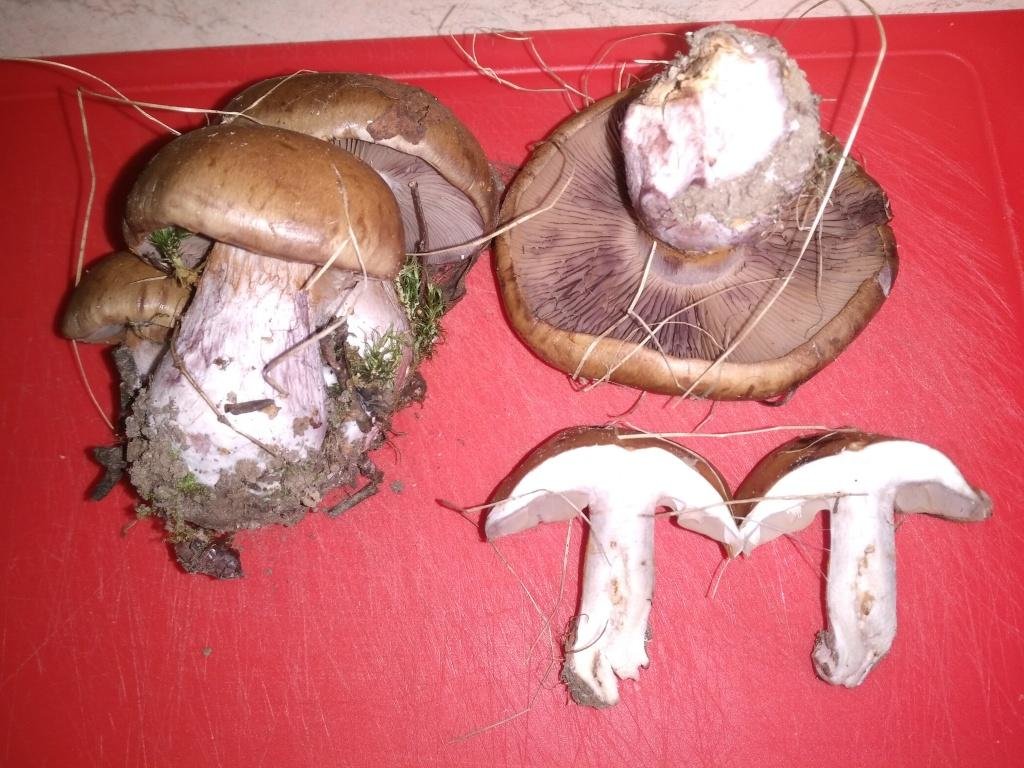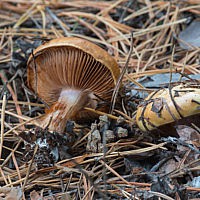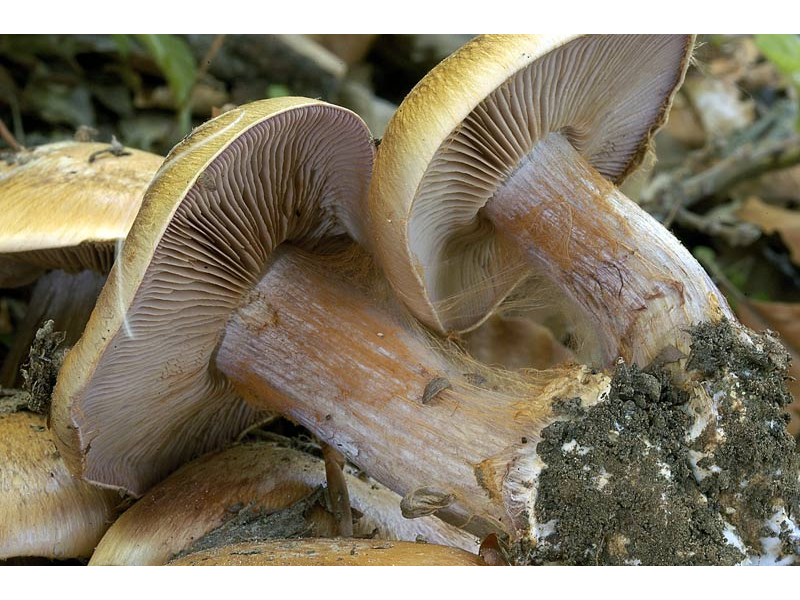Gallery: types of cobwebs (45 photos)
Webcap yellow
Cortin.triumрhans - has a hemispherical or cushion-shaped, half-open upper part of an orange-yellow coloration with the remnants of a bedspread and a sticky or dry surface covering a thick, soft, whitish-yellowish pulp with a pleasant aroma. The plates are weakly adherent, narrow and frequent, light smoky-cream or bluish-brown in color with a rusty-reddish-brown spore powder. The lower part of the fruiting body is strongly thickened, cylindrical in shape.
Webcap yellow
Webcap white-purple
Cortin.albоviolaceus - has a rounded bell-shaped, convex or convex-outstretched cap with an elevation in the central part and a silky fibrous, shiny, smooth, sticky surface of lilac-violet-silver or white-lilac coloration. Plates are medium-frequent, narrow, grayish-blue, gray-ocher or brownish-brown, with the presence of rusty-reddish-brown spore powder. The area of the leg is clavate, with weak mucous membrane. The soft part is thick and watery in places, gray-blue, brownish, with an unpleasant odor.
Bracelet webcap
Cortin.armillatus - has a hemispherical, gradually opening, cushion-shaped cap with a wide and obtuse tubercle in the central part, covered with dry and fleecy, orange or reddish-brown coloration with remnants of a red-orange-brown blanket. The soft part is thick and dense, brownish in color, with a pronounced musty odor in the absence of mushroom taste. Plates of an adherent type, wide and relatively sparsely located, grayish-cream, slightly brownish or rusty-brown in color, with brown-rusty-red spore powder. The lower part of the fruiting body is lighter, widening at the base, with bracelet-like remains of the veil.
Bracelet webcap
The webcap is special
Cortin.rubellus - has a conical or prostrate-conical cap, with a sharp tubercle in the center and a fine-scaly, reddish-orange, reddish-orange or bright brownish surface, covering the tasteless and radish-smelling flesh of a reddish-orange-orangish tinge. Thick and wide plates are rare, growing to the stem, orange-ocher or rusty-brownish in color, with rusty-reddish-brown, spherical spores with roughness. The lower part of the fruiting body is cylindrical, of sufficient density.
Also read: What do the mushrooms lines look like and where do they grow
Scaly webcap
Cortin.pholideus - has a bell-shaped, slightly convex, with a blunt elevation in the center and numerous scales of a dark brown coloration of the cap, covered with a pale brown, brownish-brown skin. It is distinguished by rare, grayish-brownish plates with a lilac-violet tint and the presence of a brown spore powder. The lower part of the fruiting body is cylindrical or weakly clavate, with an extension at the base, solid or hollow, with a smooth, grayish-brownish scaly surface. Loose type, gray-violet-brownish flesh has a faint musty odor.
Scaly webcap
Webcap noble
Cortin.géntilis - is distinguished by a hygrophane, conical, bell-shaped, convex, with an elevation in the center, a silky-fibrous or velvety-felt cap of a yellowish-reddish-brown or reddish-brown, ocher-orange or yellowish-ocher coloration with the presence of appressed scales. Plates of an adherent type, descending, rarely located wide and thick, light yellow-ocher or dark brown in color. The lower part of the fruiting bodies without thickening at the base, hollow, covered with a whitish coating, fibrous type, reddish-buffy in color.

Webcap noble
Webcap abnormal
Cortin.anomalus - differs in convexity or flat, with a dry silky or smooth surface, a cap of grayish-brown, bluish-violet, reddish-brown or brown color. The area of the leg is cylindrical, with a thickening towards the base, whitish, with a light fibrous partial veil. The soft part is whitish, with a purple tint, odorless, with a mild taste.
Light ocher webcap - Cortinarius claricolor
Written by Nikolay Budnik and Elena Meck.
Light ocher webcap comes across quite rarely. At first we thought it was an apricot Webcap. But time passed, and kind people suggested that this was not the Apricot Webcap at all, but Cortinarius claricolor.
Light ocher webcap grows in dry pine forests, among green and white moss. Usually only the hat sticks out in the moss. From a distance, a young light ocher Webcap can be confused with a porcini mushroom - your heart stops, you run to pick this mushroom as soon as possible, but when you come closer and twist a thick leg out of the moss, instead of tubes you see a white cobweb blanket and plates.
We have long met the Light ocher Webcap in the forests, and in 2010 we got the courage to try it: we cut it, boiled it just in case, and fried it. I liked the light ocher webcap very much - hard, light, tasty.
There is practically no information in the domestic literature, and foreign sources call this mushroom inedible or even slightly poisonous! Therefore, we will not recommend for collection. Themselves ate, thank God, without consequences.

1. Light ocher webcap - strong and weighty mushroom.

2. We always met him in September.

3. When you see a young light ocher spider web, sometimes you confuse it with a porcini mushroom.

4. Older copies are more difficult to confuse.

5. Light ocher cobweb grows in a dry pine forest.

6. Sometimes mushrooms are found in large families.

7. Light ocher webcap prefers rather open areas.

eight. . green and white moss.

nine. . often with lingonberry.

10. The cap of the spider web is of a light ocher noble brownish color.

11. Initially, the edges of the cap are bent down.

12. Gradually they open up and the cap becomes almost flat.

13. The plates are at first tightly covered with a light cobweb blanket.

14. You can take a closer look.

15. Then the veil disappears, and a light trace remains from it along the edge of the cap.

16. Here you can see the records up close.

17. Plates darken with time.

18. They acquire a clay color (like all cobwebs).

19. The leg of the light ocher spider web is rather long and fleshy.

20. It is light in color, usually straight and even, sometimes slightly widened downward.

21. The remains of the bedspread are often visible on the leg.

22. On a cut, the leg is solid, juicy and strong.

23. So it connects with the cap in young mushrooms.

24. The flesh of the mushroom is white, sometimes a little bluish-purple.

25. She is strong, tender and juicy. In addition, the fungus is almost not affected by insect larvae.

26. In general, I really want to eat this mushroom, which we did once.

27. The next eight photos were taken on September 13, 2012. Their history is as follows.

28. Once we were returning home with full baskets. It was already evening, twilight.

29. And then we came across a witch circle of some mushrooms. There were 45-50 of them!

30. At first it seemed that these are triumphal cobwebs.

31. But upon closer inspection, it turned out that it was not them.

32. The color of the mushrooms was a little different, the texture itself was a bit different, and, most importantly, there were no three characteristic belts on the legs.

33. We decided to take a few mushrooms and examine them more closely in the light.

34. At home we realized that it was a witch's circle cobwebs are light buffy. Such a miracle was shown to us by the goblin grandfather!
And now a small video filmed in the forests of Uloma Zheleznaya.
What does the spiderweb mushroom look like and where does it grow?
The name spiderweb means a genus of mushrooms of the family of the same name. Among mushroom pickers, the popular name pribolotnik is quite common, which reflects the peculiarities of the growth of the fungus.The mushroom got its main name due to the fact that at the junction of the leg and the cap it has a kind of cobweb, which practically disappears as it grows.
Interestingly, in appearance, different types of spider webs differ quite strongly, and novice mushroom pickers can take them for completely different families. There are fruit bodies of both classical shape and mushrooms with spherical and conical caps. The surface can be either dry or slimy, with a smooth or scaly texture. The color of the hats is also quite varied: yellow, orange, brown-red, burgundy and even white-violet.
Cobwebs grow alone, but more often in families from 10 to 30 pieces. They should be looked for in the lowlands, and they are collected mainly at the end of summer and until the onset of the first autumn frosts (late October in the European part of the country and the second half of September in Siberia).
Webcap mushroom: description and photo
Cobwebs, in all respects, are of medium size (about 5-20 cm). They usually have a not too long stem that is thin rather than thick. And located on it is a rather light and by no means large hat (up to 5 cm in diameter). The latter often has a convex and conical shape, the edges of the cap can be bent downward.
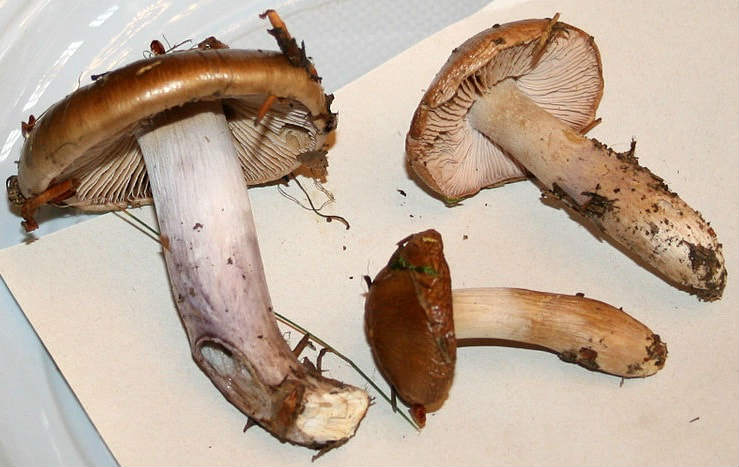
Cobwebs are lamellar mushrooms. Their main distinguishing feature may well be their bright color. They are found in purple, bright yellow, dark red, terracotta and other colors. Some of the names of the species went precisely because of this feature of them: purple spider web, crimson spider web, watery blue spider web, and others.
And the name of the whole genus of mushrooms was given by a cobweb film as a blanket enveloping its representatives. The spider web is clearly visible in young mushrooms: it connects the stem and the edges of the cap. And in mature representatives, a thin film breaks as it grows and becomes like a spider web entangling the leg of the mushroom.
All representatives of this genus have a round, flat cap as they grow, often raised in the middle. To the touch, it is smooth, fibrous, less often scaly. There may be both a mucous surface of the cap and a dry one. The pulp is fleshy, thin, often white, but it can be multi-colored. The plates are frequent, descending, and the stem is cylindrical, sometimes with a thickening at the base.
These mushrooms love moist, swampy soil. Often they can be found at the outskirts of bogs, which is why they got the name "pribolotniki". Cobwebs grow in deciduous and mixed forests, less often observed in conifers. It is a widespread genus. Their habitat is the European part of Russia, Siberia, the Far East, Ukraine, Belarus, Georgia and Kazakhstan.
In Europe, they are often found in Austria, Italy, Great Britain, Belgium, France, Finland, Switzerland, Romania, Latvia and Estonia. You can also find them in the USA and Japan. However, although they are so ubiquitous, they are quite rare mushrooms. Some of their species, for example, the purple cobweb, are listed in the Red Book of the Russian Federation and other regions.
The Spiderweb family includes several dozen species of mushrooms, and most of them grow on the territory of Russia. The most common are discussed below.
Webcap yellow
This representative is also called triumphant. It forms rather large fruiting bodies with a cap diameter of up to 12 cm. Moreover, in young representatives it resembles a sphere, and then becomes flat. In color - from yellow to brown tones.
The pulp of this type does not have a special smell and dries up rather quickly at the break. On the other hand, it is the most popular representative of the family among mushroom pickers, since its taste makes it possible to use it as a base for first and second courses, as well as for pickling and pickling.
This representative is also called red. It has a classic shape - a spherical cap of orange, ruddy and reddish shades (about 10 cm in diameter). The leg is white, fleshy, and can grow to a considerable height (up to 20 cm).
This is a rather rare species, which is mainly found in Central Europe, and in Russia it is distributed only in the forests of Bashkiria. It almost always grows in large families, so mushroom pickers gather large harvests at once.
In appearance, it resembles real mushrooms from postcards: a large hemispherical hat with rich brown, brown and burgundy shades, as well as a glossy surface (15-20 cm in diameter). The legs grow up to 14 cm in height, dense, fleshy, white.
Cooking recipes
Before cooking, you need to thoroughly rinse fresh mushrooms under running water, and then boil thoroughly, changing the water 2–4 times.
To marinate them, you need the following components:
- salt - tbsp;
- sugar - tbsp;
- peppercorns - 1 tsp;
- bay leaves - 4-5 pcs.;
- cinnamon - 0.5 tsp;
- vinegar - 1 tablespoon;
- dill - 1 bunch;
- mushrooms - 2-3 kg;
- water - 1.5 l;
- onions - 5 pcs.
Recipe:
- Boil water, add all ingredients except mushrooms to it, and cook for 10 minutes.
- Spread cobwebs in banks, pour marinade over them and roll up.
- The product will be ready in 1.5-2 weeks.
Mushrooms are also suitable for drying. The following guidelines must be followed:
- Cut the pre-processed specimens into slices. Dry them right away to maintain color and quality.
- Lay on the grates in a thin layer. Do not dry on a baking sheet, as they can burn.
- You need to start the process with a temperature of 45 degrees. This will help prevent browning of the mushrooms. And when they dry up, the temperature can be raised to 60-70 degrees.
- The oven door should be slightly open to the width of the palm of your hand to ensure adequate air circulation. During the drying process, the grates must be interchanged for uniform processing of the raw materials.
The webcap is excellent - an edible species of mushrooms, which is listed in the Red Book in Russia. By properly preparing this product, you will get a tasty and healthy dish. But picking mushrooms should only be a specialist who knows how to distinguish them from poisonous ones.
Webcap purple
This mushroom has a large, thick-fleshed head. In young mushrooms, it is bell-shaped or hemispherical, with age it opens up to half-dispersed. Has a deep purple color. The surface of the cap is velvety and dry. The flesh of the cap is loose and thick.
Colored from bright purple to off-white. Has a faint smell. The plates are rare, narrow.
The spore powder has a reddish-purple hue. In height, this mushroom can reach twelve centimeters, the thickness of the leg is up to three centimeters. The structure of the leg can change with age.
While the mushroom is young, it is whole, over time it becomes loose. Not monochromatic, has overflows up to light blue. You can meet this mushroom from late summer to mid-October. The purple webcap belongs to rare mushrooms and is listed in the Red Book, but you can find it quite often and not much.
In principle, it is impossible to call this mushroom inedible, as well as edible. Mushroom pickers do not recommend eating it, at least because of its rarity, and also note that it still does not have any special taste.
First aid for poisoning
Typical symptoms of spiderweb poisoning are: gagging, dry mouth, constant thirst, cramping abdominal pain. If these symptoms occur after eating the mushroom, you should immediately call a doctor. It is dangerous to transport a patient with suspected mushroom poisoning on your own, because some toxins affect the work of the heart. While waiting for the arrival of an ambulance, you must:
- Make a gastric lavage.
- Give a laxative.
- Give a cleansing enema.
Symptoms of poisoning with the poison of the pale toadstool
Summing up, we can say that collecting cobwebs is not the best idea for inexperienced mushroom pickers. Of course, their edible species have a very piquant taste, but a violation of the cooking technology of this product can turn into a hospital bed for a person.
Types of mushrooms and medicinal properties
Despite the fact that some of the types of spiderwebs are poisonous, this does not reduce the content of valuable substances in them, which are of practical use in medicine. Some of the representatives of this genus are used as raw materials for the manufacture of dyes. Mostly brown or ocher mushrooms are used for this.
Edible and conditionally edible representatives are successfully used for culinary purposes, having undergone additional processing in the form of prolonged boiling with frequent water changes. In cooking, such types of mushrooms are often used as watery blue spider web, excellent cobweb, purple cobweb, yellow cobweb.
These are the most common types of food. There are others, but many of them are useless and do not carry any flavor value. Be that as it may, even known species should be collected only by experienced mushroom pickers.
The most famous species of this genus are:
- yellow cobweb or triumphal spiderweb - edible;
- cobweb purple - conditionally edible;
- orange spider web - conditionally edible;
- crimson spider web - conditionally edible;
- the spider web is shiny - poisonous;
- bracelet cobweb - edible;
- changeable cobweb - conditionally edible;
- cobweb brown - conditionally edible;
- smeared cobweb - conditionally edible;
- the cobweb is excellent - edible;
- straight spider web - conditionally edible;
- reddish-olive spider web - inedible;
- cobweb cobweb - conditionally edible;
- scaly cobweb - inedible.
Webcap red
Red or blood-reddish mushroom, belongs to the category of poisonous. Bears close resemblance to the inedible purple spider web. Possesses pronounced antiseptic properties. The substances included in its composition prevent the development of tuberculous mycobacteria. Found in coniferous forests. Loves moist, mossy soil. Fruiting from July to September.
Typical signs of spiderweb poisoning are burning and dry mouth, intense thirst and subsequent vomiting, nausea, abdominal cramps. Often accompanied by headache and lumbar pain. Even if you notice the symptoms in time and consult a doctor, recovery and treatment will take quite a long time.
In order to protect yourself, it is important to remember the first rule of the mushroom picker: if there are doubts about the edibility or inedibility of the mushroom, then it is customary to consider it obviously poisonous. In general, it is better not to risk it and entrust the collection of webcases to specialists who can confidently distinguish a good mushroom from its poisonous counterpart.
Any type of poisoning requires immediate medical attention, before the arrival of an ambulance. It is advisable not to transport the patient to the clinic, as some toxins can cause disturbances in the activity of the cardiovascular system.
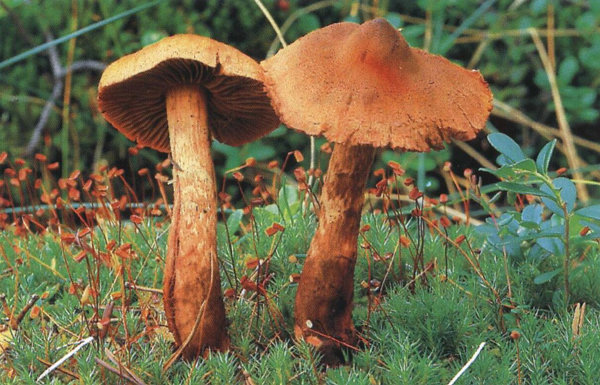
Before the arrival of the doctor, you should:
- put the patient to bed;
- carry out repeated gastric lavage;
- drink a laxative to remove poison from the intestines;
- make a cleansing enema.
If everything was done correctly, and the danger was noticed at an early stage, then after such measures, the victim in 2-3 hours can already feel an improvement in his condition.
Description of the mushroom
The common webcap, called in Latin Cortinarius trivialis, belongs to the family of Webcaps (or Cortinaria) and the genus Webcaps (agaric order). It is popularly known as Pribolotnik, as it grows mainly in wet areas. It acquired its name thanks to a kind of cobweb blanket, reminiscent of a veil-like film, which connects the edges of the cap with the leg. And the epithet "ordinary" symbolizes the classic, usual structure of the fruiting body and inexpressive color.
The cap of the mushroom reaches a diameter of 3 to 8 cm. In immature representatives of the species, it has a hemispherical, rounded-bell-shaped shape with curved edges. As the fungus grows, it becomes convex-outstretched with a wide, low tubercle in the center. At the same time, a small amount of mucus can be seen on the surface of the cap.The color varies from pale yellow or pale ocher with an olive tint to clay, honey brown and yellow brown. There are also fruiting bodies with a red-brown cap in the center and light edges.
The hymenophore (the lower part of the cap, on the surface of which there is a thin spore-bearing layer) is distinguished by wide, often located to each other, plates that grow together in the form of a tooth. In young mushrooms, this part has a yellow or whitish color, and in more mature ones, it is rusty brown or pale ocher. Also on the hymenophore, a barely noticeable cobweb cover of a whitish color with a mucous consistency is visible. The spore powder in the common spider web is yellowish-brown.
On the cut, the flesh of the mushroom is quite dense, ocher color (sometimes it acquires a light whitish tint), and closer to the base of the leg it becomes slightly brownish. The smell of the fruiting body is unpleasant, and the taste is inexpressive.
The leg of the common spider web is silky and dense. It has a cylindrical shape that tapers or sometimes widens towards the base. Its height is 5-10 cm, and its diameter is no more than 1-2 cm. In young representatives of the species, it is initially solid, and later becomes complete. The color of the leg is white, sometimes with a purple tint, brownish in the base area. The girdle on the stem resembles concentric fibers of yellow-brown and brown shades.
Centipede webcap (Cortinarius glaucopus): what it looks like, where and how it grows, edible or not
Cobweb cape (Cortinarius glaucopus (Schaeff.) Gray, 1821)

Insert-mushroom-tree Synonyms: Agaricus glaucopus Schaeff., 1774 Agaricus subcyaneus Batsch, 1783 Myxacium glaucopus (Schaeff.) P. Kumm., 1871 Phlegmacium glaucopus (Schaeff.) Wünsche, 1877
Etymology: Cortinarius (Latin cortina - cortina) glaucopus (Latin glaucus - dull).
Hat: 3-12 cm in diameter, at first hemispherical, then convex, flat and even slightly depressed in the middle, slimy, greenish-olive, yellow or orange-brown in the middle and greenish or yellow-green along the edge, often orange-reddish , with dark rusty fibers.
Plates: broadly or roundedly adherent, at first violet-bluish or gray-violet, rarely pale ocher, then the color of coffee with milk.
Stem: 3-9 x 1-2 cm, with a nodule at the base, from clear to indistinct, silky fibrous, pale grayish-violet above, below bluish or yellowish green, rarely whitish or buffy.
Flesh: yellowish, bluish in the upper part of the leg, turns brown from alkali, tasteless, with a slight unpleasant odor.
Spores: 7-9 x 4.5-5 µm, ellipsoidal to almond-shaped, finely warty.
Spore powder: brown.
Habitat: grows in coniferous and coniferous-deciduous forests.
Season: August-November.
Distribution in Kazakhstan: found in pine forests of Akmola region.
Habitat: Russia, Europe, Asia, North. America.
Edible: the mushroom is edible after preliminary boiling.
The literature describes 3 well-distinguishable varieties:
Var. glaucopus - The cap is orange-reddish, with a greenish or olive tint around the edge. The plates and stem are bluish-violet.
Var. olivaceus (Mos.) Quadr., 1984 - Greenish olive cap with reddish or dark brown ingrown fibers. The plates and stem are bluish-violet at first.
Var. acyaneus (Mos.) Nezd., 1983 - Basidiomas are completely devoid of bluish-purple and green hues. The hat is orange-reddish. The plates and stem are whitish. From species with basidiomas with whitish (not purple) plates, C. glaucopus var. acyaneus is distinguished by the reaction of the cap skin to alkali. In the former it turns brown, and in C. glaucopus var. acyaneus becomes reddish brown.

